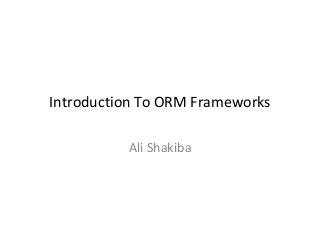
Introduction to Object-Relational Mapping
- 1. Introduction To ORM Frameworks Ali Shakiba
- 3. Procedural Vs. OO • Procedures are core • Objects are core entities entities • Data exist to feed • Objects consist of procedures execution function and data at the • Workflow relation same level between procedures • Rich OO relation: – Composition – Inheritance – Workflow – …
- 4. Object Oriented Concepts • Class & Object
- 5. Object Oriented Concepts, Cont. • Data (fields, properties, state, attributes) • Function (methods, procedures)
- 6. Object Oriented Concepts, Cont. • Reference (pointer, link, complex objects graph)
- 7. Object Oriented Concepts, Cont. • Encapsulation & Interfaces
- 8. Object Oriented Concepts, Cont. • Inheritance & Specialization
- 9. Business Logic & Domain Model • Business Logic: What should the software do? • Domain Model: OO implementation of BL.
- 10. Relational Databases Concepts • Table & Tuple • Primary Key • Foreign Key • SQL Query • Normalization • Transaction
- 12. Object-Relational Impedance Mismatch • OO does not talk SQL • Lots of SQL for lots of objects • RDBMs’ dialect • Write/change/maintain nightmare
- 13. OR Impedance Mismatch, Cont. • Moving objects between OO and RDB worlds • Load on demand • Trace and update • Identity
- 14. OR Impedance Mismatch, Cont. • RDB does not support OO concepts immediately: • Inheritance • Complex, non-normalized composition • Encapsulation and Interface
- 15. OR Impedance Mismatch, Cont. • Who • Outlive the other? • Is more expensive? • Is master/slave?
- 16. So Why Still RDB? • High performance, Powerful • Available, Everywhere • Proven – in theory – and in practice • Known in every language • Almost no dominate replacement
- 17. Solution • RDB+SQL: • JDBC (no solution!) • RDB+ORM: • Hibernate (OSS, JBoss, supports EJB3) • JDO • EJB3 (JDBC/EJB3/JDO JCP Spec, supported by Sun, IBM, Oracle, JBoss and other Java friends.) • RDB, SQL mapping: • iBATIS (IBM Prod.) • OODB: • Db4o (OSS, Recent years tries hard to prove itself! Not dominate yet!)
- 18. ORM Features • Mapping OO concepts to RDB concepts • Relationship navigation – Eager/Lazy loading • Trace & update changes – Lazy update • Map identities • Query language, CRUD API • Transparency • Transaction
- 19. ORM, Mapping OO Concepts to RDB Concepts • Inheritance – Table per Hierarchy – Lost Memory – No Modularity – Table per Class – Join, lost time – Table per Concrete Class – Redundancy
- 20. ORM, Mapping OO Concepts to RDB Concepts, Cont. • Composition – Collections (Indexed) – Value/Embedded Objects • Bi-directional reference
- 21. ORM, Relationship Navigation • Lazy Loading • Delay loading ‘e’ if it’s rare to load ‘b’ if ‘e’ is loaded • Avoid memory waste for unnecessary objects • Eager Loading • Load ‘b’ with ‘e’ if it’s common to load ‘b’ if ‘e’ is loaded • Avoid delays for loading objects
- 22. ORM, Trace, Update, Identities • Trace loaded objects • Preserve relation between objects and corresponding RDB data • Return same object for request for same data • Apply changes to object to same data in RDB • Knows which object should be update
- 23. ORM, Query Language, CRUD API • Create, Read, Update, Delete Objects in/from/to RDB • Query lang for search for objects stored in RDB • Support SQL, convert SQL result to objects
- 24. ORM, Transparency • Domain model objects should act as if they are not persistence object • Use Repository interfaces and implementation to talk to ORM framework
- 25. ORM, Transaction • An API to do atomic jobs startTransaction(); … If( everyThingIsOk){ commit(); }else{ rollback(); }
- 26. ORM, Caching • Cache loaded objects even if they are not needed any more to benefit from request for them in near future
- 27. ORM Benefits • Productivity – OOP – No SQL • Performance – Cache Objects – Lazy/Eager Loading – Lazy Updating • Portability – Different SQL dialects
- 28. When SQL? • Performance • Handwritten SQLs • Special SQL queries • Special RDBMS features • Limited SQL • Organization policy or DBA • Legacy RDBMSs or RDBs • No OO, i.e. Procedural style • Create an ORM framework
- 29. Case Study: Simple Wiki
- 30. Case Study: Simple Wiki, Cont.
- 31. Case Study: Simple Wiki, Cont.
- 32. Case Study: Simple Wiki, Cont.
- 33. Case Study: Simple Wiki, Cont.